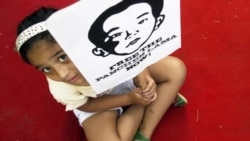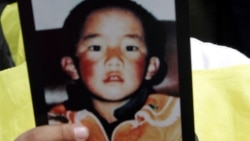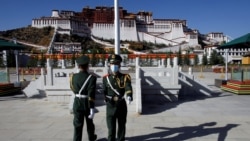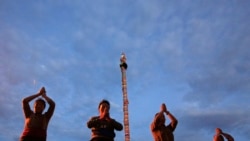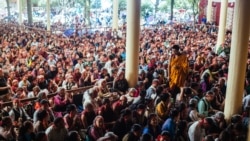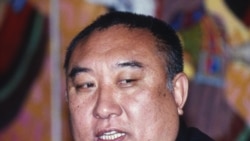On April 26, China’s Foreign Ministry was asked to comment on a U.S. State Department statement urging China to disclose the whereabouts of Gedhun Choekyi Nyima.
On May 14, 1995, Gedhun Choekyi Nyima, then six years old, was designated as the 11th Panchen Lama by the 14th Dalai Lama, Tibet's highest spiritual leader and former head of state of Tibet’s government-in-exile.
The Panchen Lama is Tibetan Buddhism’s second-most important figure.
Three days later, the Chinese government, hoping to select its own Panchen Lama, kidnapped Gedhun Choekyi Nyima and his family. Their whereabouts have never been disclosed.
On April 25, which was Gedhun Choekyi Nyima’s 33rd birthday, the State Department condemned the Chinese government for continuing “to deny members of the Tibetan community access to the Dalai Lama-designated Panchen Lama” and urged Beijing to free him.
The State Department said the U.S. supports “Tibetans’ right to select, educate, and venerate their own leaders, like the Dalai Lama and the Panchen Lama, according to their own beliefs and without government interference.”
In response, Chinese Foreign Ministry spokesman Wang Wenbin said his government “pursues policies of freedom of religious belief, including respecting and protecting the reincarnation of Living Buddhas.”
He added: “Twenty-seven years ago, when he (the Dalai Lama) was abroad, he took the liberty of declaring a child as the reincarnation of the Panchen Erdeni in order to carry out anti-China separatist political hype to the detriment of religious rituals and in disregard of historical conventions.” (Erdeni is a special title given to the Panchen Lama by Qing Emperors.)
That is misleading. In fact, the Dalai Lama holds the authority to recognize the Panchen Lama, according to Tibetan Buddhist traditions.
The rituals and conventions Wang accused the Dalai Lama of disregarding include the so-called “Golden Urn ceremony,” a Qing Dynasty law mandating that reincarnations of prominent Tibetan Buddhist monks be selected by drawing lots from a container.
Tibetans had followed that law sporadically until the Chinese Communist Party (CCP) enforced it in 1995. Beijing rigged the ceremony to put forward a Panchen Lama of its choice, who remains rejected by most Tibetans.
Tibetan “reincarnation”
The practice of finding the “reincarnation” of tulkus, or “living buddhas” who are reincarnated custodians of a specific lineage of Buddhist teachings, is a unique feature of Tibetan Buddhism.
The practice dates to the 13th century and has been used to solve the question of succession of tulkus, wrote Datta Karubaki, professor of Himalayan studies at the University of North Bengal.
For centuries, the Dalai Lama and Panchen Lama, both high-profile tulkus, have been regarded as the two most important spiritual leaders of the dominant Gelug school of Tibetan Buddhism.
Until 2011, when the Dalai Lama decided to give up his political role in the Tibetan government-in-exile and shift that power to an elected representative, Tibet was the only regime in the world where a Buddhist monk, the Dalai Lama, served as the head of government.
According to the Tibetan Buddhist tradition, once a lama dies, a search for his reincarnation begins.
“Sometimes the lamas themselves leave directions regarding rebirth in order to help the fellow monks to pursue their search,” wrote Karubaki.
"Sometimes the previous generation of lamas wrote down where my next generation was born and what the person was like," Elliot Sperling, a historian of Tibet and Tibetan-Chinese relations at Indiana University, told the Voice of America (VOA) in 2016.
“In the absence of such directions, they resort either to astrologers or an oracle, who points out in vague and obscure terms, the direction and the place where investigations must be made as well as the various signs by which the child must be identified,” Karubaki wrote. “Signs are also found in the waters of some sacred lakes which are interpreted as guidelines.”
Search teams are sent to find children born around the date of the lama’s death who match the signs. They are put through a series of tests until the right one is divined. While most Dalai Lamas were found in Tibet, the 4th Dalai Lama was found in Mongolia and the 6th in India.
Tenzin Gyatso, the 14th Dalai Lama, who won the Nobel Peace Prize in 1989, told VOA in 2016: "These are the ways that have been passed on. There are many ways to verify it (the reincarnated), such as observing dreams or observing the color and burning time of the butter lamp, or with the help of some objects, like the rosary, and plus meditation. Thoughts, feelings…It's not just one factor."
The 14th Dalai Lama said there had been a long tradition of the Dalai Lama and the Panchen Lama recognizing each other’s reincarnation. The 10th Panchen Lama said the same thing.
The ‘Golden Urn’
In 1995, however, the Chinese government resurrected the Golden Urn ceremony to install the 11th Panchen Lama of their choice rather than recognize Gedhun Choekyi Nyima.
“The rationale for the dismissal of the Dalai Lama’s choice, according to the Chinese government, was his disregard for traditional practices in the recognition of high incarnations,” Sperling wrote in a 2012 article for Studies on the History and Literature of Tibet and the Himalaya.
“It goes without saying that the underlying — albeit, quite obvious — reason was the need for the Chinese government to retain control over the structure and content of the Buddhist apparatus insofar as what are perceived as state interests were concerned.”
“The Chinese Communist Party hoped to limit the ability of the Dalai Lama and the Tibetan government-in-exile to independently identify reincarnations," says the publisher’s description of historian Max Oidtmann’s book Forging the Golden Urn. "In so doing, they elevated a long-forgotten ceremony into a controversial symbol of Chinese sovereignty in Tibet.”
Li Jianglin, an independent writer and researcher of Tibetan history, told VOA in 2016 that the Tibetan government had always tried to avoid using the Golden Urn ceremony.
"Because they never genuinely accepted it, because it was not something of Tibetan Buddhism itself. It was imposed on them for political control by another regime," she said.
A rejected selection
During its “Great Leap Forward” campaign in 1958, the Chinese communist regime, whose leader deemed religion "poison," vowed to abolish the reincarnation system in Tibet. But shortly after the 10th Panchen Lama’s sudden death in 1989, China began to lead the search for his reincarnation.
According to Arjia Rinpoche, the former abbot of Kumbum Monastery who now lives in exile in the United States (Rinpoche is a Tibetan honorific term used for abbots of Buddhist monasteries and other revered spiritual teachers), Beijing made Chadrel Rinpoche the leader of the search team. Chadrel Rinpoche was abbot of the Tashi Lhunpo Monastery and regarded by Beijing as “politically competent.”
Yet, Chadrel Rinpoche insisted that only the Dalai Lama, the supreme spiritual leader of Tibet, had the power to decide the next Panchen Lama and threatened to quit the search team.
Through a messenger, Chadrel Rinpoche secretly contacted the 14th Dalai Lama in exile in India, sending pictures and other information about a group of Panchen Lama candidates that the search team had found.
In January 1995, the Dalai Lama confirmed Gedhun Choekyi Nyima to be the 11th Panchen Lama, but Beijing refused to accept the candidate and insisted on using the Golden Urn ceremony.
On May 14, 1995, Chadrel Rinpoche was detained in Chengdu and placed under house arrest. He was sentenced to six years in prison in 1997 on charges of “colluding with overseas separatist forces and revealing state secrets.”
His whereabouts since the expiration of his sentence in 2002 are unknown.
On May 16, 1995, the Chinese Foreign Ministry announced that it would not recognize Gedhun Choekyi Nyima as the next Panchen Lama. The next day, Gedhun Choekyi Nyima and his family were taken by the Chinese authorities and have not been seen since.
And a rigged selection
On November 29, 1995, under Beijing’s direction, the Golden Urn ceremony was held in the Jokhang Temple in Lhasa, Tibet. Gyaincain Norbu, a 5-year-old boy whose parents were Chinese Communist Party members, won the lottery to become the 11th Panchen Lama.
However, according to Arjia Rinpoche, who attended the ceremony, the lottery was manipulated.
On the flight back to Beijing, he heard Ye Xiaowen, then head of China’s State Administration for Religious Affairs, tell other officials that they made the stick with Gyaincain Norbu’s name on it slightly longer by stuffing cotton in it. That stick was chosen, he said.
According to “Why Tibet Is Burning,” published by the Tibetan Policy Institute in 2013, Arjia Rinpoche said the Chinese government had forced him “to play a part in the selection of the 11th Panchen Lama.”
“I was an eyewitness to the fact that the ritual was a farce and that the selection was rigged,” he said. “It was totally manipulated.”
After being confirmed by Beijing, the 11th Panchen Lama never returned to Tibet. He was permanently placed in a mansion in Beijing and was later married to a Han Chinese woman.




